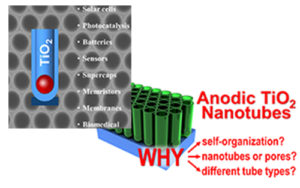One-Dimensional Titanium Dioxide Nanomaterials: Nanotubes / Aligned metal oxide nanotube arrays: key-aspects of anodic TiO2 nanotube formation and properties
 Over the past ten years, highly-defined layers of TiO2 nanotubes and aligned nanoporous arrays have attracted tremendous scientific and technological interest due to their impact on energy conversion, environment remediation and biocompatibility. In the two recently published review papers (Chemical Reviews 2014, and Nanoscale Horizons 2016), we try to give an overview on the state of the art of research on TiO2 nanotubes, their formation, properties, and applications. We review synthesis approaches based on e.g. templating techniques, and mainly focus on the most promising routes that, in our view, are self-organizing electrochemical anodization and hydrothermal methods: by adjusting simple experimental parameters, these techniques offer a fine morphology control over the fabricated materials. In particular, for anodic tubes, we start with the fundamental question: why is self-organization taking place? We illustrate the inherent key mechanistic aspects that lead to tube growth in various different morphologies (ripple-walled tubes, smooth tubes, stacks and bamboo-type tubes, double-walled versus single-walled TiO2 tubes, etc.) and point out the drastic difference in their physical and chemical properties (e.g., optical and electronic properties). We review the most widely used strategies for the modification of TiO2 properties (surface decoration, doping, band gap engineering, etc.) that also apply to nanotubular arrays and, finally, outline their impact on functional uses of self-organized nanotubes (e.g., as anodes in dye-sensitized solar cells, for photocatalysis or as biomedical coatings, in ion-intercalation devices, etc.).
Over the past ten years, highly-defined layers of TiO2 nanotubes and aligned nanoporous arrays have attracted tremendous scientific and technological interest due to their impact on energy conversion, environment remediation and biocompatibility. In the two recently published review papers (Chemical Reviews 2014, and Nanoscale Horizons 2016), we try to give an overview on the state of the art of research on TiO2 nanotubes, their formation, properties, and applications. We review synthesis approaches based on e.g. templating techniques, and mainly focus on the most promising routes that, in our view, are self-organizing electrochemical anodization and hydrothermal methods: by adjusting simple experimental parameters, these techniques offer a fine morphology control over the fabricated materials. In particular, for anodic tubes, we start with the fundamental question: why is self-organization taking place? We illustrate the inherent key mechanistic aspects that lead to tube growth in various different morphologies (ripple-walled tubes, smooth tubes, stacks and bamboo-type tubes, double-walled versus single-walled TiO2 tubes, etc.) and point out the drastic difference in their physical and chemical properties (e.g., optical and electronic properties). We review the most widely used strategies for the modification of TiO2 properties (surface decoration, doping, band gap engineering, etc.) that also apply to nanotubular arrays and, finally, outline their impact on functional uses of self-organized nanotubes (e.g., as anodes in dye-sensitized solar cells, for photocatalysis or as biomedical coatings, in ion-intercalation devices, etc.).
Lee, K.; Mazare, A.; Schmuki, P. One-Dimensional Titanium Dioxide Nanomaterials: Nanotubes. Chem. Rev. 2014, 114, 9385. DOI: 10.1021/cr500061m
Riboni, F.; Nguyen, N.T.; So, S.; Schmuki, P. Aligned metal oxide nanotube


